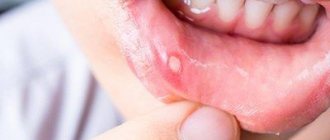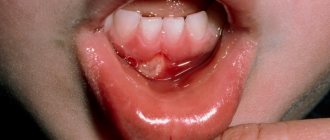Dentist-therapist
Spivak
(Therapist) Evgenia Ivanovna
Experience 28 years
Dentist
Make an appointment
Stomatitis is a characteristic inflammation of the oral mucosa. More common in children, this is due to the habit of not washing their hands and “tasting” surrounding objects. It can act as an independent disease or develop against the background of mechanical damage, infections or dental diseases. Manifestations of pathology are different: from small ulcers to large inflammations over the entire surface of the mucosa. Provided that you seek medical help in a timely manner and take a course of medication under the supervision of a doctor, it can be completely cured.
Causes of stomatitis
The list of causes of stomatitis is varied. Provoking factors include:
- diseases of the gastrointestinal tract and oral cavity;
- consequences of chemotherapy;
- mechanical injuries to the gums and oral mucosa, burns from hot food;
- unbalanced diet, hypovitaminosis;
- side effect in the development of cancer;
- consequences of hormonal disorders;
- addiction to nicotine and alcohol;
- infection of the oral mucosa;
- chronic diseases;
- lack of proper oral hygiene;
- long-term use of medications.
Knowing and eliminating the causes of stomatitis will allow you to successfully cope with the disease and reduce the risk of its recurrence.
List of categories of patients at risk
- Children under 7 years old. More than half of cases of stomatitis occur in preschool children due to the lack of the habit of regularly washing their hands.
- Elderly people with diseases of internal organs and loss of several teeth.
- Persons living in unsanitary conditions, as well as those who refuse to observe the rules of personal hygiene.
- Smokers, regardless of length of service.
- Persons with reduced immunity after severe illness, chemotherapy or organ transplantation.
- Patients who have undergone a long course of antibiotic treatment.
- Persons with asthma who use inhalers without following hygienic rules for their use.
The frequency of cases of stomatitis is from 5 to 20%, depending on living conditions: less in large cities, more in rural areas where there is no centralized water supply or the water quality is considered unsatisfactory.
Care is important
Proper care of a child during illness is no less important than taking medications. With an enterovirus infection, a small patient will have to be switched to liquid food for several days - fermented milk dishes, liquid porridge, pureed puree soup - which will not be so painful for him to swallow. The temperature of the food should be close to the child's body temperature.
It is not advisable to bathe your baby during the acute period, but it is possible if necessary. The main thing is that the water temperature should not be higher than 35 C, because... Any warming procedures are strictly prohibited.
In the room where the sick child is located, it is advisable to maintain moist, cool air and carry out wet cleaning daily, for which you can use antiseptic solutions.
Irina Gennadievna: “Enteroviruses spread very easily and quickly. Therefore, for 10 days from the moment the first symptoms of the disease appear, the child must be isolated as much as possible - in a separate room. He should have his own separate dishes, toys and towel. Adults caring for a patient should wash their hands with soap or antiseptic after each contact with him, and have as little contact as possible with objects touched by the child. It is advisable to have one person take care of the baby, and all other family members avoid contact with him, because The disease is highly contagious and can be severe in adult patients.”
- share with your friends!
Experts: Irina Gennadievna Eremeeva
Types of stomatitis
Depending on the reasons that caused the inflammation, infectious and non-infectious diseases are distinguished:
- viral stomatitis - caused by the consequences of an infectious disease or the effects of pathogenic microorganisms on the damaged oral mucosa. It looks like bubbles with transparent contents that gradually become cloudy. Ulcers form at the site of burst blisters;
- bacterial – consequences of damage to the body by staphylococci or streptococci. Under favorable conditions, they quickly spread throughout the mucous membrane, on which purulent foci form;
- fungal - characterized by the formation of numerous ulcers with a white coating;
- radiation – the consequences of ionizing radiation in the form of painful erosions and hardening of the mucous membrane;
- chemical – associated with burns of the mucous membrane, after healing of which dense scars form;
- aphthous - one of the popular types of stomatitis, is associated with reduced immunity and the consequences of gastrointestinal diseases. Small ulcers with a diameter of up to 5 mm are painful and quickly grow in size;
- allergic – caused by exposure to external irritating factors, goes away completely without treatment when the allergen is eliminated: foods, medications, incorrectly selected dentures, etc.
What systemic diseases can manifest as aphthae?
- Reiter's syndrome
- Behçet's disease
- AIDS
- cyclic neutropenia
- PFAPA syndrome
The gastroenterologist is especially interested in the connection between recurrent ulcers and specialized systemic diseases.
Celiac disease is found in 5% , and for a long time canker sores may be the only manifestation of a reaction to gluten.
Let me remind you that the estimated prevalence of celiac disease in the general population is about 1%.
Enamel defects and aphthous stomatitis in celiac and healthy subjects: Systematic review and meta-analysis of controlled studies
Other important conditions that manifest as canker sores are inflammatory bowel diseases: Crohn's disease and ulcerative colitis.
Extraintestinal Manifestations of Pediatric Inflammatory Bowel Disease: Prevalence, Presentation, and Anti-TNF Treatment
Symptoms of stomatitis
The type of stomatitis can often be determined by characteristic signs of the disease associated with the cause of its occurrence. All of the above types of pathology are united by:
- the appearance of characteristic ulcers and areas of inflammation on the oral mucosa;
- the formation of white, yellow or green plaque, under which traces of mucosal erosion are visible;
- redness on the gums;
- enlarged lymph nodes;
- unpleasant bloody or putrid taste in the mouth;
- soreness of the affected areas;
- increased salivation.
Signs of stomatitis in adults and children can be more or less pronounced depending on the state of the immune system, compliance with personal hygiene rules and living conditions.
Are you experiencing symptoms of stomatitis?
Only a doctor can accurately diagnose the disease. Don't delay your consultation - call
What does aphthous stomatitis look like?
Aphthae occur on the inside of the cheeks or lips, under the tongue, at the base of the gums, or on the soft palate.
https://img.medscapestatic.com/pi/meds/ckb/75/43075.jpg
They can be confused with manifestations of herpetic infection , but the latter usually appears at the red border of the lips, rarely in the oral cavity - usually on the gums or hard palate.
Aphthae first look like red bumps (papules), which then quickly turn into ulcers, surrounded by a red rim and covered with a gray-yellow coating (exudate). 1-2 days before the appearance of aphtha, there may be a local burning sensation of the mucous membrane.
Sometimes the child or family members notice what often triggers the appearance of aphthae. Journaling can help with this.
According to American data, about 20% of the population suffered from recurrent aphthous stomatitis at one time or another in their lives.
Most often children suffer and usually these are minor canker sores.
The peak incidence of aphthae is 1-19 years.
Possible complications of stomatitis
The requirement to immediately consult a doctor at the first signs of stomatitis is dictated by concern for the health and well-being of the patient. Ignoring this rule may cause:
- damage to the mucous membrane of the entire oral cavity;
- development of infectious diseases of internal organs;
- inflammation of the gums and loss of some teeth;
- digestive problems;
- infection of loved ones through kissing, sharing utensils, etc.;
- diseases of the heart, lungs and blood.
Self-medication can lead to similar consequences. Therefore, if you suspect stomatitis, you should immediately seek help from a therapist or pediatrician.
Conclusions:
Aphthae in the mouth recur at some point in life in almost 20% of all people, most often in the second decade of life.
It is difficult to establish a clear and unambiguous reason.
If recurrent aphthae occurs, the pediatrician, physician, or dentist should consider the possibility that rare aphthae are a manifestation of a serious systemic disease.
In such situations, the gastroenterologist must exclude celiac disease, Crohn's disease and ulcerative colitis.
2, total, today
Diagnosis of the disease
In most cases, an external examination of the patient is sufficient to make a diagnosis. If teeth and gums are affected, a dentist is involved in consultation. If a secondary nature of the disease is suspected, causing inflammation of the mucous membrane, highly specialized doctors can begin working with the patient.
Diagnosis of infectious stomatitis has its own characteristics. Special laboratory tests allow you to determine the type of pathogenic organism that caused the inflammatory process:
- oral swab for testing for fungi and bacteria;
- blood test for the presence of antibodies to pathogens of infectious diseases of internal organs;
- smear or PCR (polymerase chain reaction) blood test to detect and analyze the DNA of viruses.
If the disease is accompanied by an increase in body temperature and a serious deterioration in health, the patient is referred for blood and urine tests. This will identify possible complications or infectious diseases that cause inflammation of the oral mucosa.
What can help in finding the cause of aphthae?
A conversation sometimes helps to find out whether relatives have important diseases with a family predisposition - celiac disease, Crohn's disease, lupus erythematosus.
During the examination, the doctor can evaluate the general manifestations of the disease (not typical with ordinary recurrent aphthous stomatitis) and check for the presence of ulcers outside the oral cavity.
The simplest laboratory examination is carried out - this is most often enough.
A general blood test may show anemia due to deficiency of iron, folic acid, and vitamin B12.
The level of neutrophils is also assessed - their decrease may be a sign of the rare systemic disease cyclic neutropenia
A high ESR may be a sign of Crohn's disease and ulcerative colitis.
Serum iron levels may be reduced in up to 20% of recurrent canker sores.
Treatment options
When visiting a doctor in the first stages of the disease, treatment of stomatitis at home is symptomatic and lasts about a week. When an infectious cause of the disease is established, the action plan changes:
- a course is prescribed that relieves inflammation and other main symptoms;
- local gels and ointments are prescribed;
- drugs are selected that act on the causative agent of the disease to completely destroy it.
The complex of drugs for the treatment of infectious stomatitis includes antibiotic compounds, painkillers, antiseptic and antihistamine medications. The duration of this course is about 10 days. If the diagnosis establishes the secondary nature of the disease and serious pathologies are identified in the patient’s body, the treatment process may be delayed until the possible provoking factors are completely eliminated.
Additional methods to speed up the recovery process and increase the effectiveness of medications for stomatitis include:
- avoidance of foods that cause irritation to the mucous membranes;
- increasing the volume of fermented milk products in the diet;
- rinsing the mouth with calendula decoctions;
- lubricating ulcers with sea buckthorn oil, aloe juice or petroleum jelly.
Treatment of stomatitis in adults should be carried out under the supervision of a physician. This approach will eliminate possible side effects and promptly adjust the course to increase its effectiveness.
Prevention of stomatitis
You can eliminate the risk of inflammation of the mucous membrane and the development of stomatitis by following the following recommendations:
- stop smoking and drinking alcohol;
- use antibiotics only as prescribed by a doctor, strictly in the indicated doses;
- maintain oral hygiene;
- promptly treat diseases of teeth and gums;
- reduce the amount of sweet foods and yeast baked goods;
- choose toothpastes and rinses from leading manufacturers;
- Avoid eating too hot, cold or spicy foods;
- take vitamin complexes and strengthen your immune system.
Additional recommendations based on the patient’s health condition will be provided by the attending physician.
What do doctors advise for home care?
The specialist makes a diagnosis and prescribes treatment, and the implementation of all instructions falls entirely on the shoulders of the parents. Caring for a small child with stomatitis contains many nuances. For example, during this period you should feed your baby only warm food with a mushy consistency, excluding citrus, sour and spicy foods. After eating, be sure to rinse your mouth. If the baby is still very small, then after eating you should give him a little boiled water to drink. Treatment of the oral cavity and application of gels prescribed by a doctor should be done with a special fabric fingertip or a finger wrapped in a bandage (the bandage should then be thrown away).
Important: self-medication is dangerous. Only a doctor can correctly diagnose and give the correct therapeutic recommendations.
Questions and answers
How to treat stomatitis at home?
Prescribing medications for stomatitis is possible only after examination by a specialist and establishing the causes of the disease. All types of stomatitis are treated at home according to the prescribed course of medications for internal use and local healing agents. The patient is admitted to the hospital only in an emergency, if the examination reveals a serious pathology of the internal organs.
Is stomatitis contagious or not?
The fungal or infectious nature of stomatitis makes the patient a source of spreading the disease to others. If the disease is caused by an allergic reaction, gastrointestinal pathology or mechanical damage to the gums, there is no danger of infecting loved ones. It is possible to indicate the exact cause of the development of the inflammatory process only after examining the patient and studying the test results. Before visiting a doctor, you should limit contact with family and strictly observe personal hygiene rules.
How long does it take to treat stomatitis?
If you consult a doctor early, you can completely cope with the disease within a week. If the inflammation is caused by a problem in the internal organs, stomatitis takes longer to treat, depending on the degree of development of the underlying pathology. The sooner the risk factors are eliminated, the faster the symptoms will be eliminated.










